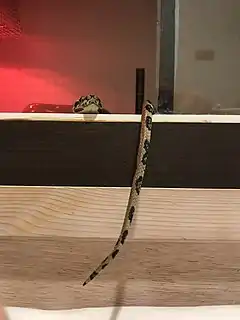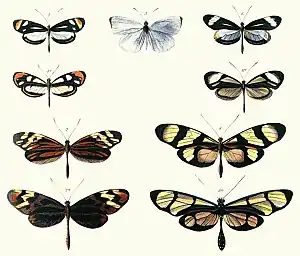Caudal luring
Caudal luring is a form of aggressive mimicry in which a predator uses tail movements to attract prey.[1] The prey animal misinterprets the tail as a worm-like species or another smaller prey. Once the prey animal is within striking range, the predator attacks. Snakes, often juveniles, and some types of shark are the main species that practice caudal luring.

The mimicry was initially interpreted as a warning sign displayed under stressful circumstances. The study of the tail movements suggested that the behavior evolved from tail vibration. Researchers have also used different experiential paradigms to investigate stimulus control and visual deception in snakes.
Mimicry
The tail of a species may serve various functions, such as aggression, defense and feeding.[1] The caudal luring behavior was first recorded in 1878[2] and is an instance of aggressive mimicry.[3] Predators attract their prey by moving their caudal section in a way that mimics the victim's own prey. The prey is intrigued by caudal behavior and will investigate assuming it is their own prey.[1]
Species
Snakes
Caudal luring behavior is found in over 50 different snake species.[4] It is most common in boas, pythons, tropidophiids, colubrids and elapids of the genus Acanthophis.[5][6] It is, however, the most obvious in vipers and pit vipers, especially in rattlesnakes.[7] As the snake is waiting for its prey, it is coiled up and has its distinctively marked tail elevated, visible and moving in a way that captures the attention of its prey. Once the prey is in striking range, the snake captures the prey. Due to the tail resembling a writhing caterpillar and another worm-like insect larvae, the tail of the snake is often referred to as a vermiform.[4] One elaborate example of caudal luring occurs in the spider-tailed horned viper, which employs a highly modified tail to mimic a spider's form and locomotion.[8]
Caudal luring is more frequently observed in juvenile snakes. Of the snakes that practice the caudal luring behavior, 80% of the snakes are juvenile.[9] The tails of juvenile snakes are often a vibrant color, making them difficult to ignore. As the juvenile snakes mature into adulthood, their tail color will become consistent with the rest of their body.[10] Juvenile snakes have a smaller lure compared to the size of an adult's lure. Studies show that a smaller lure is more effective in attracting prey, as it is closer to the size of the worm-like prey. This may explain why caudal luring is more often seen and successful in younger snakes.[11]
Sharks
Caudal luring is found in some sharks, being common among three species: Alopias vulpinus, Alopias superciliosus and Alopias pelagicus; they have tails (elongated dorsal lobes of the caudal fin) of varying shapes, but they all use them to attract and then immobilize prey.[12]
The tasselled wobbegong (Eucrossorhinus dasypogon) a carpet shark, has a caudal fin resembles a small fish with a small dark eyespot; this is waved slowly to attract prey.[13][14]
Other
Caudal luring behavior is believed to occur in pelican eels.[7]
Evolution
It has been suggested that caudal luring was involved in the evolution of the tail vibration rattle of rattlesnakes, a warning signal and a way of auditory communication, though this has been challenged.[15][16][17][1] Prey luring, in general, is confounded by false interpretation, as the wiggling of an appendage could have other behavioral meanings including aposematism, defence, or nervous release, and experimental evidence has been weak.[1][18][16]
Caudal luring is thought to have evolved from a caudally localized intention movement[16] (a behavior derived from locomotor movements). Essentially, the act of remaining stationary while sensing prey produces general nervous system excitation that gets released in the form of tail movements. Caudal luring is not merely tail undulations, but must specifically be attractive to prey. Caudal distraction is another behavior used by snakes, and the tail motions are similar to caudal luring. The difference is in the snake's posture and especially in the nature and outcome of the behavior in reference to the encounter with prey.[19] Other caudal luring-like movements occur as warning signals and are induced by stressful circumstances.[1]
References
- Tiebout, Harry M. (1997). "Caudal Luring by a Temperate Colubrid Snake, Elaphe obsoleta, and Its Implications for the Evolution of the Rattle among Rattlesnakes". Journal of Herpetology. 31 (2): 290–292. doi:10.2307/1565399. JSTOR 1565399.
- "Short Notes". Amphibia-Reptilia. 23 (3): 343–374. 2002. doi:10.1163/15685380260449225. ISSN 0173-5373.
- Vane-Wright, R. I. (March 1976). "A unified classification of mimetic resemblances". Biological Journal of the Linnean Society. 8 (1): 25–56. doi:10.1111/j.1095-8312.1976.tb00240.x.
- Jackson, R. R.; Cross, F. R. (2013). "A cognitive perspective on aggressive mimicry". Journal of Zoology. 290 (3): 161–171. doi:10.1111/jzo.12036. ISSN 1469-7998. PMC 3748996. PMID 23976823.
- Chiszar, David; Boyer, Donal; Lee, Robert; Murphy, James B.; Radcliffe, Charles W. (September 1990). "Caudal Luring in the Southern Death Adder, Acanthophis antarcticus". Journal of Herpetology. 24 (3): 253. doi:10.2307/1564391. JSTOR 1564391.
- Carpenter, Charles C.; Murphy, James B.; Carpenter, Geoffrey C. (October 1978). "Tail Luring in the Death Adder, Acanthophis antarcticus (Reptilia, Serpentes, Elapidae)". Journal of Herpetology. 12 (4): 574. doi:10.2307/1563366. JSTOR 1563366.
- Labib, Ramzy S.; Awad, Ezzat R.; Farag, Nagi W. (January 1981). "Proteases of Cerastes cerastes (Egyptian sand viper) and Cerastes vipera (Sahara sand viper) snake venoms". Toxicon. 19 (1): 73–83. doi:10.1016/0041-0101(81)90119-7. ISSN 0041-0101. PMID 6784280.
- Fathinia, Behzad; Rastegar-Pouyani, Nasrullah; Rastegar-Pouyani, Eskandar; Todehdehghan, Fatemeh; Amiri, Fathollah (2015). "Avian deception using an elaborate caudal lure in Pseudocerastes urarachnoides (Serpentes: Viperidae)". Amphibia-Reptilia. 36 (3): 223–231. doi:10.1163/15685381-00002997. Footage of the spider-tailed horned viper using its tail to lure a migrating bird featured in the Asia episode of the BBC series Seven Worlds, One Planet narrated by David Attenborough.
- Sazima, Ivan; Puorto, Giuseppe (February 1993). "Feeding Technique of Juvenile Tropidodryas striaticeps: Probable Caudal Luring in a Colubrid Snake". Copeia. 1993 (1): 222. doi:10.2307/1446315. ISSN 0045-8511. JSTOR 1446315.
- Labib, Ramzy S.; Awad, Ezzat R.; Farag, Nagi W. (January 1981). "Proteases of Cerastes cerastes (Egyptian sand viper) and Cerastes vipera (Sahara sand viper) snake venoms". Toxicon. 19 (1): 73–83. doi:10.1016/0041-0101(81)90119-7. ISSN 0041-0101. PMID 6784280.
- Hagman, M.; Phillips, B. L.; Shine, R. (December 2008). "Tails of enticement: caudal luring by an ambush-foraging snake (Acanthophis praelongus, Elapidae)". Functional Ecology. 22 (6): 1134–1139. doi:10.1111/j.1365-2435.2008.01466.x. ISSN 0269-8463.
- Aalbers, S. A.; Bernal, D.; Sepulveda, C. A. (May 2010). "The functional role of the caudal fin in the feeding ecology of the common thresher shark Alopias vulpinus". Journal of Fish Biology. 76 (7): 1863–1868. doi:10.1111/j.1095-8649.2010.02616.x. ISSN 0022-1112. PMID 20557638. S2CID 205226057.
- Michael, Scott W. (2001). Aquarium sharks & rays : an essential guide to their selection, keeping, and natural history. T.F.H. ISBN 1890087572. OCLC 46449134.
- Ceccarelli, D. M.; Williamson, D. H. (February 2012). "Sharks that eat sharks: opportunistic predation by wobbegongs". Coral Reefs. 31 (2): 471. Bibcode:2012CorRe..31..471C. doi:10.1007/s00338-012-0878-z. ISSN 0722-4028.
- Schuett, Gordon W.; Clark, David L.; Kraus, Fred (May 1984). "Feeding mimicry in the rattlesnake Sistrurus catenatus, with comments on the evolution of the rattle". Animal Behaviour. 32 (2): 625–626. doi:10.1016/S0003-3472(84)80301-2. S2CID 53177551.
- Reiserer, R. S. (2002). "Stimulus control of caudal luring and other feeding responses: A program for research on visual perception in vipers". Biology of the Vipers. Eagle Mountain, Utah Eagle Mountain Publishing. 2002 (1): 361–383. doi:10.1016/S0003-3472(84)80301-2. S2CID 53177551.
- Sisk, Norman R.; Jackson, James F. (August 1997). "Tests of Two Hypotheses for the Origin of the Crotaline Rattle". Copeia. 1997 (3): 485. doi:10.2307/1447554. JSTOR 1447554.
- Reiserer, Randall S.; Schuett, Gordon W. (September 2008). "Aggressive mimicry in neonates of the sidewinder rattlesnake, Crotalus cerastes (Serpentes: Viperidae): stimulus control and visual perception of prey luring". Biological Journal of the Linnean Society. 95 (1): 81–91. doi:10.1111/j.1095-8312.2008.01016.x. ISSN 0024-4066.
- Mulin, S. J. (1999). "Caudal distraction by rat snakes (Colubridae, Elaphe): A novel behaviour used when capturing mammalian prey". Great Basin Naturalist. 59: 361–367.
